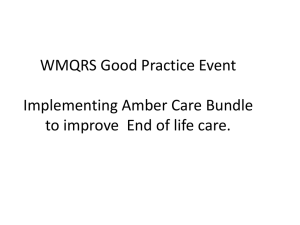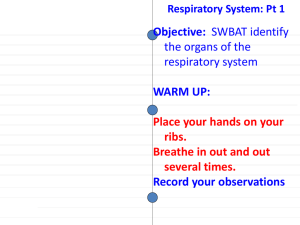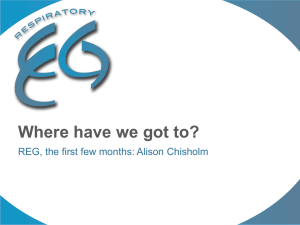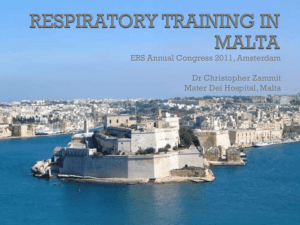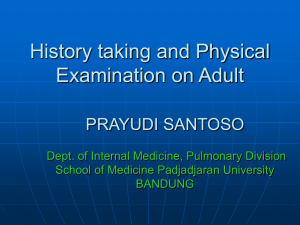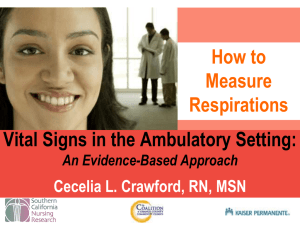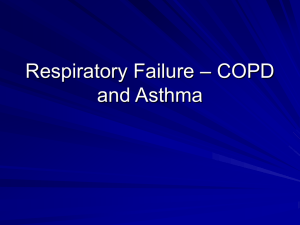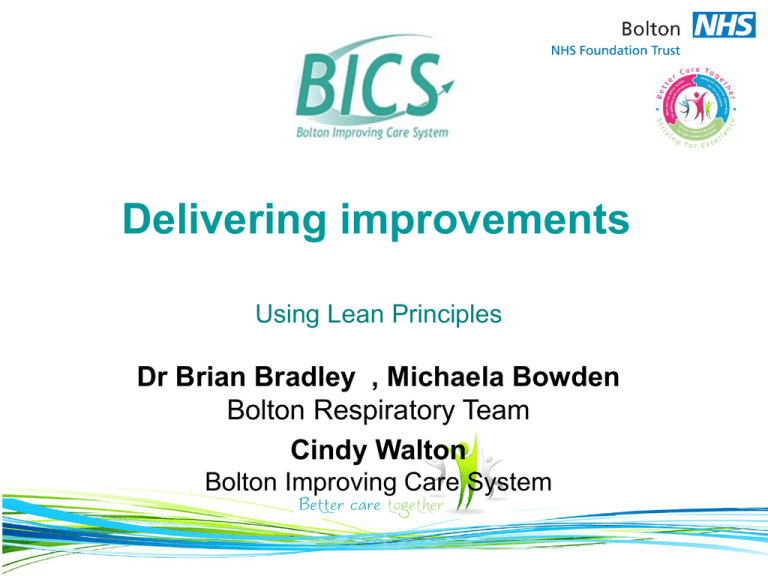
Delivering improvements
Using Lean Principles
Dr Brian Bradley , Michaela Bowden
Bolton Respiratory Team
Cindy Walton
Bolton Improving Care System
About Bolton
• Northern industrial town
• Population 270,000
• 12% ethnic minority population
Bolton health survey
epidemiology
COPD
Chronic Bronchitis
Chronic Cough
13.5%
Wheezing
2.7%
7.5%,
18.7%
We are
here!
About Bolton NHS FT
• Currently 775 beds –
Catchment approx
350,000
• Busiest emergency service
in the North West
• 2011/12 £260m turnover
• 46,000 non-elective
admissions per year
• Respiratory illness is high
volume pathway (27%)
The Bolton Improving Care
System
Understanding
Value
Learning
To
See
Delivering
Benefit
Redesigning
Care
Why Change?
•
•
•
•
•
Difficult Winter
Care unsafe
98% not being achieved
Stressed Staff
We needed to change
Concept of Flow
•
•
•
•
•
Applying concept of flow
Value adding steps
How could it we apply to ward activities
Batch –common way
One piece flow would not be possible on
ward
• One decision flow
One Decision Flow
• Right People present to make decisions
flow
• Ward Rounds – Daily Consultant Lead
• Board Rounds Daily
• Decisions being made on a daily basis by
the right people
• Not Traditional
Bolton Respiratory Team
In-patient care - case for
Change
Staff Opinions
• All work very hard but
don’t always deliver the
good care to our patients
• High bed occupancy
figure
• Not enough time or staff
to change things
• Must be able to do things
better!
Targets!
• High Standardised
Mortality Ratio 118.9
Jan 2009
• Length of Stay
-14,183 Excess bed days
• High mortality for
respiratory conditions
• Not implementing
pneumonia care bundles
as well as we should
Respiratory Team Vision
• Timely, equitable inpatient access to respiratory
services
• Best cost-effective outpatient multi disciplinary
team (MDT) services
• Support primary care to provide equitable good
quality respiratory care in community
• Underpinning ethos of ‘Best Possible Care for
the Patient’ in the most appropriate setting
Respiratory team: lean
journey with BICS
• 2006
• 2009
• 2010
• 2012
Minor changes but sustainability
issues
Respiratory Inpatient Care
Hospital and Community
Respiratory Nursing Event
Respiratory Outpatient Service
Opening Access and Community Facing
What do our patients want from a
service?
Kano Model used
to identify from
patients what do
they want from a
service
Contact out of
hours
Delighter
(‘unspoken’)
Straight to
Respiratory Ward
Performer
Contact in hours
Frustrating‘Having to
explain to
junior doctors
when
breathless,
‘history taking’
Straight to Respiratory Ward, Management Plan
Basic (‘unspoken’)
Access
‘Listen To’
Right Medication @ Right Time
Rapid Improvement EventApril 2009
Core Group of Staff
• Nursing Staff
• Consultants + non
consultant hospital
doctors (NCHDs)
• Physiotherapy
• Occupational Therapy
• Pharmacy
• Social Workers
• External (to the process)
4 Day Event!
• Gap Analysis
• Agree new ways of
working
• Support this Standard
work model
• Devise a model to sustain
the changes
Gap Analysis:
As reported by staff
Medical issues
• Poor documentation
• Poor discharge planning
• Poor communication with
nursing and other staff
• No role in MDT
• Poor follow through on issues
• Juniors – reactive working
• 75% Discharge scripts done on
day of discharge
Nursing
• Not enough staff
• Chasing up doctors to do the
tasks / To take out drugs for
patients on discharge from
hospital (TTOs)
• Interruptions –40% of time
delivering
• Drugs -i.v. antibiotics
• Handover / prioritise work
• Social work referrals and
discharge planning
Agreed - Needed to Change/
Improve
• Simple evidence based pathways
• Improve Patients journey - ensuring visible
status and review this daily
• Monitor: Visible accountability, improved
documentation with completion tasks
• Visible proactive discharge planning process –
TTOs and Summary
• Strengthen Multidisciplinary Team Working with
Clarity of responsibility better Co-ordinating Care
New Ward Day Plan
• 7.00 am: Observations
• 7.30-9am: Nurse handover and drug round
• 9am: Daily consultant ward round with NCHDs
and bay nurse
• Daily 11.30 Multidisciplinary Ward Meeting:
Consultant led, bay nurse, NCHDs, therapy
staff and social worker
• PM: Ward work procedures, paperwork,
teaching & training, relatives
STANDARD WORK FOR WARD ROUNDS
RESPIRATORY WARDS
Performed by:
Medical &
Nursing staff
1
2
3
4
5
6
7
8
9
10
11
Stage: Daily throughout patients’ stay
Ward round will start at 9am each day.
Aims
Identify and document the diagnosis
Check appropriate treatment for severity of illness (Drug chart)
Check response to treatment - check observations, EWS, fluid balance results
Identify new issues / problems (medical, nursing or social)
Check VTE prophylaxis assessment
Working diagnosis / coding (real time)
Identify DNAR, ceiling of treatment ( NIV)
Patient information / education
Update Discharge information & Social Work Log.
Complete all documentations in clinical notes including a clear management plan
Review Drug prescription sheet with particular emphasis on:
antibiotic prescription -consider transfer to oral antibiotic treatment on a daily basis.
Please sign wardex to indicate review of i.v. antibiotics.
Check Oxygen is prescribed and administered appropriately
Review the need fluid balance, completing IV Fluid prescription if required
Decide any actions or investigations required
Allocate tasks
Nursing
Junior medical staff – Investigations, results, re-write drug wardex
Identify any issues for the board round, including notifying Social Worker to attend MDT for complex issues around identified patient.
Identify patients for Discharge Process
TTOs for next day discharges should be completed between 12 noon and 2 pm
Same day discharge TTOs to be completed on the ward round – if possible
Discharge letter to be completed before patient leaves the ward
INR to be completed at 6am on the day of discharge.
Weekend planning when appropriate
IV antibiotics / Nebs / O2 / Warfarin / Drug charts
Clarify NIV arrangements
Fluids
Request weekend bloods /Investigations and arrange results reviews
Re-write wardex Discharges and TTOs when appropriate
Complete Sustainment Graph Daily
Visual Management –
ExtraMed
Daily Update
• Admission date
• Original predicted
discharge date
• Current predicted
discharge date
• Status: on target/at
risk/overdue/exempt
• Comment field – social
issues section 2/5 awaiting
Room Patient
Name
Actions from Rapid
Improvement Event (RIE)
Implementation Time Table
• May 2009 Board Round /
MDT commence
• June - Respiratory
Consultant daily ward round
on 1 ward and MDT
• Review of process August
2009
September 2009 –
Respiratory Consultant on
both wards, new outpatients
(OPD) system
New Consultant Job Plans
• Consultant on each ward weeks slots. Males or
females on AMRU/HDU/ICU
/consults
• 3 Consultants off wards increased number of clinics,
bronchoscopy lists Student
teaching
• Continue medical on call
rota, Respiratory NIV rota.
Holidays / study leave when
in OPD
Confirmed State
a
Go
b
Improved Health
Bed Occupancy
c
Value for Money
Planned vs Actual
Best Possible Care Delays
d
30, 60, 90 day Measures - underpinned by our 4 True Norths
Joy and Pride
Start / Finish on time
No Go
08
08
08
08
Au
gu
st
Se
08
pt
em
be
r0
8
O
ct
ob
er
No
08
ve
m
be
r0
De
8
ce
m
be
r0
8
Ja
nu
ar
y
09
Fe
br
ua
ry
09
M
ar
ch
09
Ap
ril
09
M
ay
09
Ju
ne
09
Ju
ly
09
Au
gu
st
Se
09
pt
em
be
r0
9
O
ct
ob
er
No
09
ve
m
be
r0
De
9
ce
m
be
r0
9
Ju
ly
Ju
ne
M
ay
Ap
ril
Number of Discharges
Discharges from D3 & D4
250
200
150
100
50
0
Month
Number of Transfers to ICU/HDU
Number of Patient Transferred from D3/D4 to ICU/HDU
25
20
15
10
5
0
April 08
June 08
August 08
October
08
December
08
February
09
April 09
June 09
Month
Total
Mea
UCL
August 09
October
09
December
09
February
10
Proportion of All Patients Readmitted
10.50%
10.00%
9.50%
9.00%
Trend
8.50%
8.00%
7.50%
7.00%
Apr-08 May-08 Jun-08 Jul-08 Aug-08 Sep-08 Oct-08 Nov-08 Dec-08 Jan-09 Feb-09 Mar-09 Apr-09 May-09 Jun-09 Jul-09 Aug-09
Month
Source: Dr Foster 2/2/2010
Time to specialist wards
100%
24 hrs
80%
50 random Patients
September 2012
Non electiveDirect
admissions
24 hrs
60%
24 hrs
40%
140 random patients
reviewed March 2010
25-50 hrs
24 hrs
24 hrs
51-+ hrs
20%
25-50 hrs
25-50 hrs
25-50 hrs
25-50 hrs
25-50 hrs
Elective direct
0%
30 days60 days90 days Mar-10 Sep-12
Respiratory Nursing Team – 2009/10
Why change ?
• High input into respiratory ward no longer
necessary
• Focusing non respiratory areas supporting
implementation of best practice
• Inequity among the patient groups
• Focusing input earlier in the patient’s
journey
• Non-patient contact time handovers/travel
Rapid Experiment – same
resources
• Respiratory nurse specialist on wards 7
days
• Board round aiming for early respiratory
review
• Fast track to most appropriate area
• Support non-respiratory areas
• Liaise with other specialist nurses
• Re-organisation of community working
RNS Ward / Base Cell
How visits
are
organised
1 Piece
Flow
Pre- 6S Score
12.5%
Post Score
6S
Standard
work
Pull
93 – 100%
How are we
doing at a
glance?
Where are
staff located
Agreed
best way
of
working
Clear standard
work, for pulling
specialist skills/
also pulling
patients to the
right ward
Visual Management
(c) 2011 Royal Bolton Hospital NHS Foundation Trust. All rights reserved. This document may be copied for use in the NHS only on
the condition that Royal Bolton Hospital NHS Foundation Trust is acknowledged as the copyright holder and originator of the work.
Home Visits
90
80
34.5%
increase in
70
60
Average
50
40
2009
2010 /11
30
Average 38
Pre Event 800 miles / month
10
Post improvement 624 miles / month 22%
reduction per month on average
Number of home visits
20
0
jul
aug
sep
oct
nov
dec
Jan
Feb
Mar
Apr
May
Jun
Jul
Specialist Nurses Respiratory Team mileage January to September 12
900
Average 459 /
month
800
700
600
500
400
300
200
100
0
Jan-12
Feb-12
Mar-12
Apr-12
May-12
Jun-12
Jul-12
Aug-12
Respiratory nurse visits January to August 12
250
Average 147 / month
200
150
100
50
0
Jan-12
Feb-12
Mar-12
Apr-12
May-12
Jun-12
Jul-12
Aug-12
May-11
Apr-11
Mar-11
Feb-11
Jan-11
Dec-10
Nov-10
200
Oct-10
Sep-10
Aug-10
Jul-10
Jun-10
May-10
Apr-10
Mar-10
Feb-10
Jan-10
Dec-09
Nov-09
Oct-09
Sep-09
Aug-09
Jul-09
Jun-09
May-09
Apr-09
Pneumonia mortality
HSMR
Linear
(HSMR)
250
New Ways of working
RNS May 2010
150
100
50
0
Pneumonia RAMI- April 11- June 12
Patients seen by RNS (new way)
80%
70%
60%
50%
COPD
40%
30%
Pneumonia
Asthma
Bronchiectasis
20%
10%
0%
ILD
Respiratory team: lean
journey with BICS
• 2006
• 2009
• 2010
• 2012
Minor changes but sustainability
issues
Respiratory Inpatient Care
Hospital and Community
Respiratory Nursing Event
Respiratory Outpatient Service
How can we provide the best cost effective
MDT outpatient services?
• Outpatient Services – short
waiting time (best). 100% 2
week rule target, 1:2 New to
Follow up ratio
• Need full MDT Specialist clinics
for some Chronic Diseases
• Eliminate waits - Redesign
current clinics
• Introduce MDT specialty clinics
for complex patients
• Comprehensive range of Clinics • Care closer to home – income
generation such as sleep
/ Services. But some provided
services
elsewhere – Sleep
• Demand & need for alternatives
to admission and GP advice
services
• Single point of contact for
advice and/or slot in admission
avoidance clinic
Respiratory Assessment Clinics
Referral Source
1.Community Team
(Med/Nursing)
Booking
Assessment
Outcome
Discharge with
treatment plan
Choose & Book
Clinic slots
Respiratory
Assessment
Clinic
Urgent
investigations
Diagnosis
Discharge with
H.A.H Services
Treatment
2. Hospital Team
(Bleep 2000)
Respiratory Triage
•Advice
•Same day clinic
3. Self Referral
(Agreed list)
Same day
correspondence
Admit
Specialty Multidisciplinary Team
Follow-up Clinic
Better Community Working
Current Community Working
Disease Management Team
• General Practitioner with Special
Interest in Respiratory Disease
Respiratory Clinics
Supports Community Team
Consultant liason
• Nursing Team: Community
Matrons, Active Case Managers,
District Nurses, Respiratory Nurses
• Pulmonary Rehabilitation
Poor community uptake – need to
broaden access
• Education Events on End of Life
Care
Gold Standard Framework
Instant Access – October 2012
• Shorten Clinic waiting times:
Routine referral 24-48hrs
Exacerbations – same day review
• Immediate telephone advice
7 days for primary care
• Impact:
Better Care
2-3 less A/E patients per day
• Paid Tariff between that of
OPD and A/E rate
• Agreement in principle with
Commissioners
Measure
2009/10
2010/11
2011/12
LoS*
Dr Foster
CHKS
8.9 days
6.4 days
6.9 days
5.7 days
7.8 days
5.8 days
Mortality (HSMR)
119
91
79 RAMI
Readmissions
9.5%
8.5%
8.2%
ICU Escalation
101pts
64pts
57 pts
Home Visits
(per month)
38
58
92 Aug, 146 per
month
RNS Time to Care
(patient facing time)
26.25
Hrs/wk
52.5
52.5
Respiratory Team Vision
1. Timely equitable inpatient access to
Respiratory Services
2. Best cost-effective outpatient MDT
services
3. Support primary care to provide
equitable good quality respiratory care in
community
4. Underpinning ethos of ‘Best Possible
Care for the Patient’ in the most
appropriate setting
Thank you


